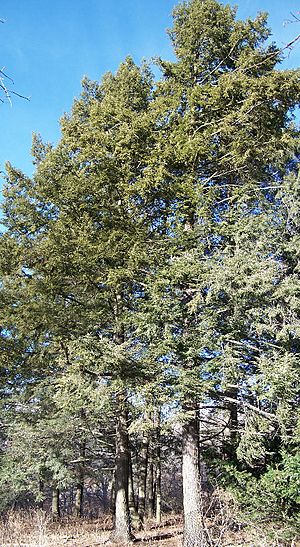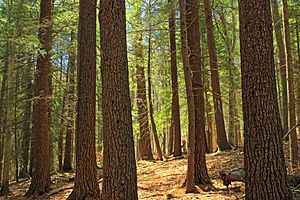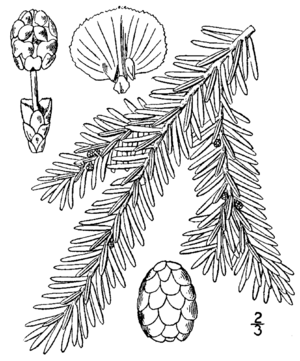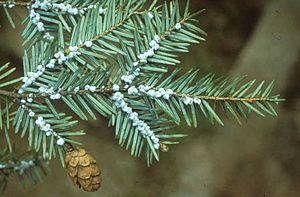Eastern hemlock facts for kids
Quick facts for kids Eastern hemlock |
|
|---|---|
 |
|
| Large specimens at Morton Arboretum | |
| Conservation status | |
| Scientific classification | |
| Genus: |
Tsuga
|
| Species: |
canadensis
|
 |
|
| Natural range | |
 |
|
| Closeup view of range | |
The Eastern Hemlock (scientific name: Tsuga canadensis) is a type of coniferous tree. This means it's an evergreen tree that produces cones, like a pine or spruce. It grows naturally in eastern North America. You might also hear it called "Canadian hemlock." It's even the official state tree of Pennsylvania!
Contents
- What Does an Eastern Hemlock Look Like?
- What is Eastern Hemlock Wood Used For?
- Where Do Eastern Hemlocks Grow?
- The Hemlock Woolly Adelgid: A Big Threat
- How Eastern Hemlocks Have Changed Over Time
- Amazing Eastern Hemlock Trees
- Growing Eastern Hemlocks in Gardens
- Other Uses of Eastern Hemlock
- Images for kids
- See also
What Does an Eastern Hemlock Look Like?
Eastern hemlocks are amazing trees that can live for a very long time. One tree found in Pennsylvania was at least 554 years old! These trees can grow quite tall, usually around 31 meters (about 100 feet). Some extra-tall ones have even reached 53 meters (about 174 feet). The trunk can be very wide, often 1.5 meters (about 5 feet) across.
The trunk is usually straight, and the tree has a wide, cone-shaped top. Its brownish bark is scaly and has deep cracks, especially as the tree gets older. The small branches are yellowish-brown and have tiny hairs. The buds are very small, only about 1.5 to 2.5 millimeters long.
The leaves are flat and usually grow in two rows, about 15 to 20 millimeters long. The bottom of the leaf is a pale, bluish-green color with two clear white stripes. These stripes are where the tree "breathes" through tiny holes called stomata. The top of the leaf is shiny green. The edges of the leaves have very tiny teeth.
The seed cones are small and egg-shaped, about 1.5 to 2.5 centimeters long. The scales on the cones are rounded. Each tree has 24 chromosomes in its DNA.
What is Eastern Hemlock Wood Used For?
The wood of the Eastern Hemlock is soft and light brown. It's often used for building things like houses and crates. It's also good for railroad ties because it holds spikes very well. However, if the wood isn't treated, it doesn't last long when exposed to rain and sun. It's not a great wood for burning as fuel. The wood is also used to make pulp for paper.
Where Do Eastern Hemlocks Grow?

Eastern hemlocks grow from northeastern Minnesota all the way east to southern Quebec and Nova Scotia in Canada. They also grow south along the Appalachian Mountains into northern Georgia and Alabama. You can find them in places with cool and humid weather. They often grow on rocky hillsides, in ravines, and other places that have a lot of moisture.
In the northern parts of their range, winters are very cold, and summers are mild. In the southern parts, winters are milder, and the summers are warmer with more rain.
The Hemlock Woolly Adelgid: A Big Threat
Sadly, Eastern Hemlocks are currently threatened by a tiny insect called the hemlock woolly adelgid (Adelges tsugae). This bug is from East Asia and was accidentally brought to the United States. It's a "sap-sucking bug," meaning it feeds on the tree's sap, which is like the tree's blood.
The adelgid has spread very quickly, especially in the southern Appalachian Mountains. It has killed thousands of hemlock trees in just a few years. Scientists are working hard to save these important trees. For example, a project called "Tsuga Search" is trying to find and protect the largest and tallest Eastern Hemlocks in the Great Smoky Mountains National Park.
Studies show that this pest is killing hemlocks faster than expected, changing how these forests work. Researchers are also trying to fight the adelgid by releasing special beetles, like Laricobius nigrinus, that naturally eat the hemlock woolly adelgid. These beetles are from the Pacific Northwest, where they help control similar pests. Scientists hope these beetles can help protect the hemlock trees in the wild.
How Eastern Hemlocks Have Changed Over Time
Scientists have studied pollen from thousands of years ago to learn about how hemlock populations have changed. About 5,500 years ago, the Eastern Hemlock population dropped a lot for about 1,000 years. Scientists think this might have been caused by diseases, insects, or changes in the climate. The trees grew back after this big decline, but they didn't become as common as they once were.
Amazing Eastern Hemlock Trees
Because Eastern Hemlocks can live for so long, some very large and impressive trees exist. Groups like the Eastern Native Tree Society (ENTS) work to find and measure these giant trees. In the southern Appalachians, many hemlocks are over 45 meters (about 148 feet) tall. One tree in the Great Smoky Mountains National Park was measured at 52.8 meters (about 173 feet) tall, but it has since died from the hemlock woolly adelgid. The tallest living one is 51.8 meters (about 170 feet) tall.
Some of these trees also have very wide trunks, often between 0.75 and 1.8 meters (about 2.5 to 6 feet) across. The largest Eastern Hemlock ever measured had a trunk volume of 44.8 cubic meters (about 1,582 cubic feet). This makes it the largest evergreen conifer in the eastern United States!
Growing Eastern Hemlocks in Gardens
Tsuga canadensis is a very popular tree to plant in gardens and parks. It's special because it grows well in shady spots where other evergreen trees might struggle. People like its soft, delicate leaves that hang down, its pyramid shape, and how well it can be trimmed.
When planting them, Eastern Hemlocks like soil that is a little bit acidic, rich in nutrients, and moist but drains well. They are often planted alone, in small groups, or trimmed into dense hedges. However, they don't do well near roads where salt is used in winter, as the salt can hurt their leaves. They also don't make good windbreaks because strong winds can damage them in winter.
One big problem for cultivated hemlocks is the hemlock woolly adelgid, but there are treatments available. Also, because their needles fall off quickly after being cut, they are not good choices for Christmas trees.
Eastern Hemlocks were first brought to British gardens in 1736. In the UK, you can often see them in gardens and parks. In Germany, they are the most common type of hemlock grown and are also used in forestry.
Different Types of Eastern Hemlock
There are over 300 different types, or "cultivars," of Eastern Hemlock that people have chosen to grow. Many of these are smaller, dwarf forms or shrubs. Here are a few popular ones:
- Beehive – This is a very small, dwarf shrub that looks like a spreading beehive. It usually grows to about 1 meter (3 feet) high and 1.5 meters (5 feet) wide.
- Bennett – This dwarf shrub grows to 1 meter (3 feet) high and 1.5 meters (5 feet) wide. Its branches first go up and then arch over. It prefers partial shade.
- Cole's Prostrate – This type grows low to the ground and can also be used for bonsai. It slowly reaches only 30 centimeters (1 foot) tall with a 1.3-meter (4.3-foot) spread. It also likes partial shade.
- Gentsch White – This dwarf shrub grows to 1.3 meters (4.3 feet) tall and wide. Its new spring growth turns creamy-white in autumn and winter, which looks amazing against the dark green older leaves. It needs partial shade because the sun can easily scorch it.
- Jeddeloh – This dwarf shrub grows to 1 meter (3 feet) high and 1.5 meters (5 feet) wide and has a small dip in the center. It has won an award from the Royal Horticultural Society.
- Pendula – This is an upright weeping form that can be staked to different heights, but is usually seen 0.6 to 1.5 meters (2 to 5 feet) tall with a 1.5-meter (5-foot) spread. It has also won an award.
- Sargentii – This is a popular large weeping shrub that grows to 3 meters (10 feet) tall with a wide spread of up to 6 meters (20 feet). It has many hanging branches and looks great near water, in rock gardens, or on slopes.
Other Uses of Eastern Hemlock
Early American pioneers used the leafy twigs of the Eastern Hemlock to make tea. They also used its branches as brooms. You can make tea from the needles. The inner bark can be eaten raw or boiled, especially in winter and early spring. It can also be ground into flour.
Images for kids
See also
 In Spanish: Tsuga del Canadá para niños
In Spanish: Tsuga del Canadá para niños







